To start this cleaning, carefully remove the stem of the pipe from the bowl and lay the two pieces on a paper towel. Dip a regular pipe cleaner in alcohol and run it through the stem, from the tenon to the mouthpiece, pulling it through. It will most likely come out with a bit of black or brown gunk on it. Follow this pipe cleaner with a dry one, and repeat the process until the moist pipe cleaner comes out the same color it was when it went in. Push one final dry pipe cleaner through to remove any moisture and set the stem aside. Using bristle pipe cleaners, moistened with alcohol, vigorously swab out the airhole of the pipe, alternating with dry, regular pipe cleaners. Don't be afraid to use a lot of pipe cleaners doing this. Pipe cleaners are cheap; new pipes aren't. If the airhole of your pipe is large enough in diameter that there is little resistance when you do this, you may want to fold the cleaner in half in order to scrub the sides of the airhole properly. Once your dry pipe cleaner comes out of the airhole the same color it was when it went in, run one more dry cleaner through the airhole to absorb any residual moisture. Using a cotton swab or shank brush, clean out the mortise, the portion of the pipe where the stem attaches to the bowl. A doubled over regular pipe cleaner will do in a pinch. If your stem or bowl has a band, now is the time to polish it, using a good silver, or other metal, polish, depending on what your band is made of. Carefully reinsert the stem into the bowl, and give the pipe a good wipe with a soft cloth, perhaps impregnated with a compound such as the Savinelli Magic Cloth. Cleaning over, allow your pipe to sit for a day or so before smoking it, to allow the alcohol to completely evaporate. If you have cleaned most or all of your briar pipes at once, now is a good time to smoke your meerschaums and corncobs you have been neglecting. Link To start this cleaning, carefully remove the stem of the pipe from the bowl and lay the two pieces on a paper towel. Dip a regular pipe cleaner in alcohol and run it through the stem, from the tenon to the mouthpiece, pulling it through. It will most likely come out with a bit of black or brown gunk on it. Follow this pipe cleaner with a dry one, and repeat the process until the moist pipe cleaner comes out the same color it was when it went in. Push one final dry pipe cleaner through to remove any moisture and set the stem aside. Using bristle pipe cleaners, moistened with alcohol, vigorously swab out the airhole of the pipe, alternating with dry, regular pipe cleaners. Don't be afraid to use a lot of pipe cleaners doing this. Pipe cleaners are cheap; new pipes aren't. If the airhole of your pipe is large enough in diameter that there is little resistance when you do this, you may want to fold the cleaner in half in order to scrub the sides of the airhole properly. Once your dry pipe cleaner comes out of the airhole the same color it was when it went in, run one more dry cleaner through the airhole to absorb any residual moisture. Using a cotton swab or shank brush, clean out the mortise, the portion of the pipe where the stem attaches to the bowl. A doubled over regular pipe cleaner will do in a pinch. If your stem or bowl has a band, now is the time to polish it, using a good silver, or other metal, polish, depending on what your band is made of. Carefully reinsert the stem into the bowl, and give the pipe a good wipe with a soft cloth, perhaps impregnated with a compound such as the Savinelli Magic Cloth. Cleaning over, allow your pipe to sit for a day or so before smoking it, to allow the alcohol to completely evaporate. If you have cleaned most or all of your briar pipes at once, now is a good time to smoke your meerschaums and corncobs you have been neglecting. Link To start this cleaning, carefully remove the stem of the pipe from the bowl and lay the two pieces on a paper towel. Dip a regular pipe cleaner in alcohol and run it through the stem, from the tenon to the mouthpiece, pulling it through. It will most likely come out with a bit of black or brown gunk on it. Follow this pipe cleaner with a dry one, and repeat the process until the moist pipe cleaner comes out the same color it was when it went in. Push one final dry pipe cleaner through to remove any moisture and set the stem aside. Using bristle pipe cleaners, moistened with alcohol, vigorously swab out the airhole of the pipe, alternating with dry, regular pipe cleaners. Don't be afraid to use a lot of pipe cleaners doing this. Pipe cleaners are cheap; new pipes aren't. If the airhole of your pipe is large enough in diameter that there is little resistance when you do this, you may want to fold the cleaner in half in order to scrub the sides of the airhole properly. Once your dry pipe cleaner comes out of the airhole the same color it was when it went in, run one more dry cleaner through the airhole to absorb any residual moisture. Using a cotton swab or shank brush, clean out the mortise, the portion of the pipe where the stem attaches to the bowl. A doubled over regular pipe cleaner will do in a pinch. If your stem or bowl has a band, now is the time to polish it, using a good silver, or other metal, polish, depending on what your band is made of. Carefully reinsert the stem into the bowl, and give the pipe a good wipe with a soft cloth, perhaps impregnated with a compound such as the Savinelli Magic Cloth. Cleaning over, allow your pipe to sit for a day or so before smoking it, to allow the alcohol to completely evaporate. If you have cleaned most or all of your briar pipes at once, now is a good time to smoke your meerschaums and corncobs you have been neglecting. Link https://www.smokingpipes.com/information/howto/cleaning.cfm



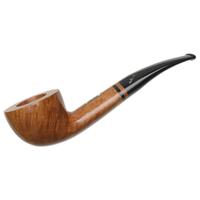
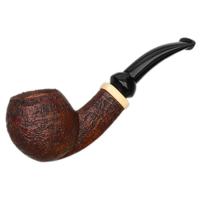
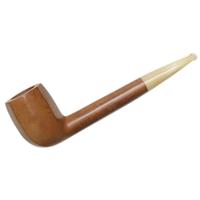
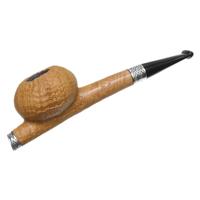
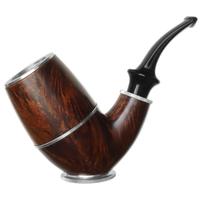





 :
: